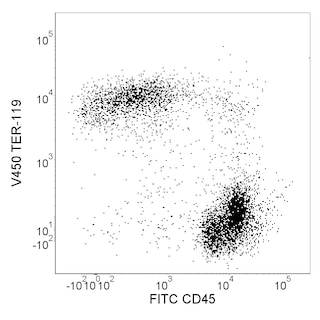Old Browser
This page has been recently translated and is available in French now.
Looks like you're visiting us from {countryName}.
Would you like to stay on the current country site or be switched to your country?


.png)

Multicolor flow cytometric analysis of CD36 expression on BALB/c mouse bone marrow cells. Bone marrow cells were stained simultaneously with BD Horizon™ V450 Rat anti-Mouse Ter-119 antibody (Cat. No. 560504) and with either PE Mouse IgA, κ isotype control (Cat. No. 562141, Left Panel) or PE Mouse anti-mouse CD36 antibody (Cat.No. 562702, Right Panel). Two-color flow cytometric dot plots show the correlated expression patterns of CD36 (or Ig isotype control staining) versus Ter-119 for gated events with the forward and side light-scatter characteristics of viable bone marrow cells. Flow cytometry was performed using a BD™ LSR II Flow Cytometer System.
.png)

BD Pharmingen™ PE Mouse Anti-Mouse CD36
.png)
Regulatory Status Legend
Any use of products other than the permitted use without the express written authorization of Becton, Dickinson and Company is strictly prohibited.
Preparation And Storage
Product Notices
- Since applications vary, each investigator should titrate the reagent to obtain optimal results.
- An isotype control should be used at the same concentration as the antibody of interest.
- Please refer to www.bdbiosciences.com/us/s/resources for technical protocols.
- Caution: Sodium azide yields highly toxic hydrazoic acid under acidic conditions. Dilute azide compounds in running water before discarding to avoid accumulation of potentially explosive deposits in plumbing.
- For fluorochrome spectra and suitable instrument settings, please refer to our Multicolor Flow Cytometry web page at www.bdbiosciences.com/colors.
- BD Horizon V450 has a maximum absorption of 406 nm and maximum emission of 450 nm. Before staining with this reagent, please confirm that your flow cytometer is capable of exciting the fluorochrome and discriminating the resulting fluorescence.
Companion Products

.png?imwidth=320)

The CRF D-2712 monoclonal antibody specifically binds to mouse and rat CD36, an 88-kDa glycoprotein member of the class B scavenger receptor family. CD36 is a multifunctional receptor that has a variety of ligands and is expressed on many cell types. Consequently, it is known by several names, including macrophage scavenger receptor, platelet glycoprotein IV, and fatty acid translocase. Cells that express CD36 include platelets, megakaryocytes, monocytes/macrophages, dendritic cells, erythroid precursors, microvascular endothelia, skeletal, cardiac, and smooth muscle cells, adipocytes, and epithelia of retina, breast, and intestine. This multi-ligand receptor functions in the clearance of apoptotic cells and abnormal erythrocytes (in malaria and sickle-cell anemia), the transport of long-chain fatty acids and oxidized low-density lipoproteins, the regulation of angiogenesis by mediating the effects of thrombospondin-1, and the mediation of coronary vasoconstriction. Crosslinking of cell-surface CD36 with plate-bound CRF D-2712 antibody promotes internalization of photoreceptor outer segment fragments by cultured retinal pigment epithelium.

Development References (3)
-
Bodart V, Febbraio M, Demers A, et al. CD36 mediates the cardiovascular action of growth hormone-releasing peptides in the heart. Circ Res. 2002; 90(8):844-849. (Biology). View Reference
-
Febbraio M, Hajjar DP, Silverstein RL. CD36: a class B scavenger receptor involved in angiogenesis, atherosclerosis, inflammation, and lipid metabolism. J Clin Invest. 2001; 108(6):785-791. (Biology). View Reference
-
Finnemann SC, Silverstein RL. Differential roles of CD36 and alphavbeta5 integrin in photoreceptor phagocytosis by the retinal pigment epithelium. J Exp Med. 2001; 194(9):1289-1298. (Immunogen: Immunofluorescence, Immunoprecipitation). View Reference
Please refer to Support Documents for Quality Certificates
Global - Refer to manufacturer's instructions for use and related User Manuals and Technical data sheets before using this products as described
Comparisons, where applicable, are made against older BD Technology, manual methods or are general performance claims. Comparisons are not made against non-BD technologies, unless otherwise noted.
For Research Use Only. Not for use in diagnostic or therapeutic procedures.